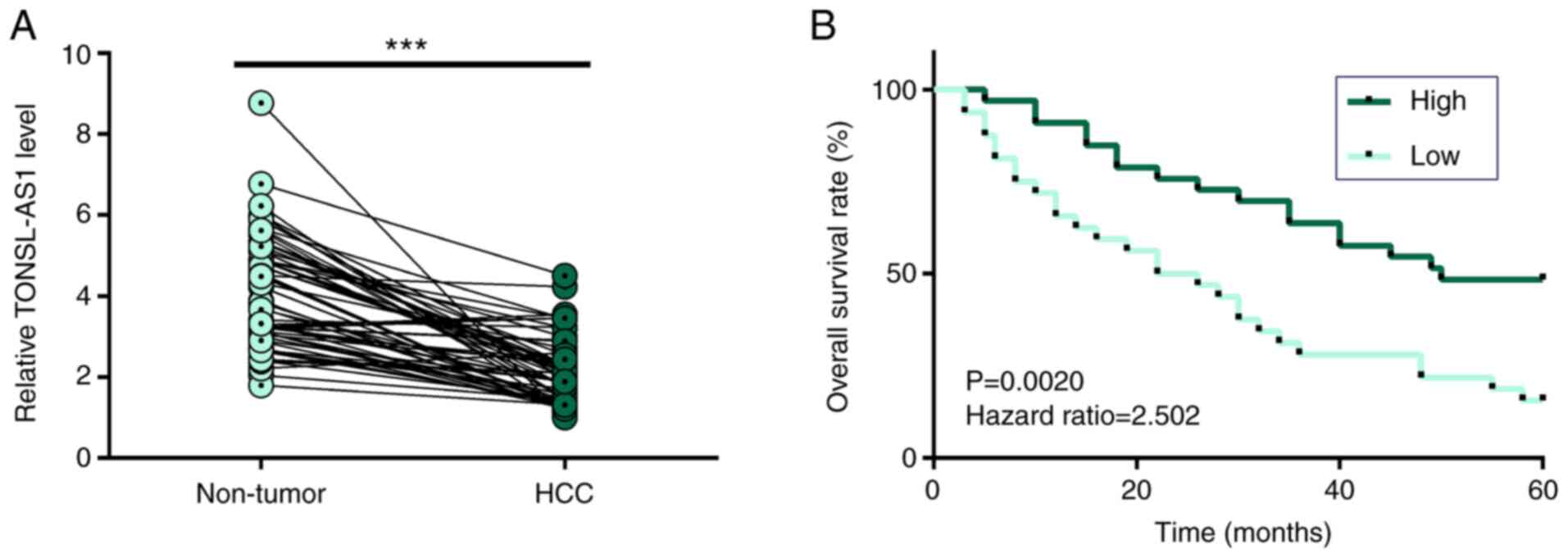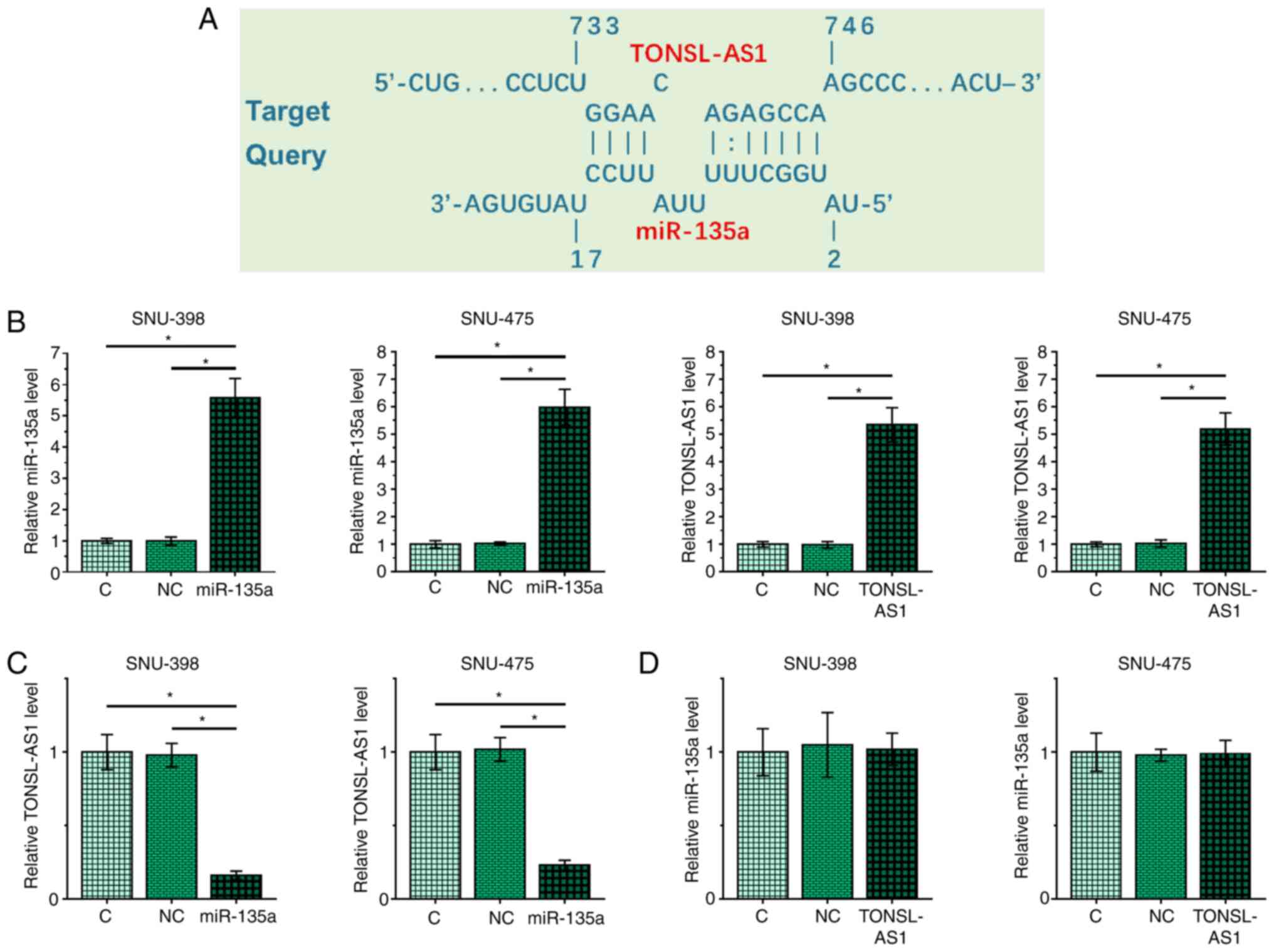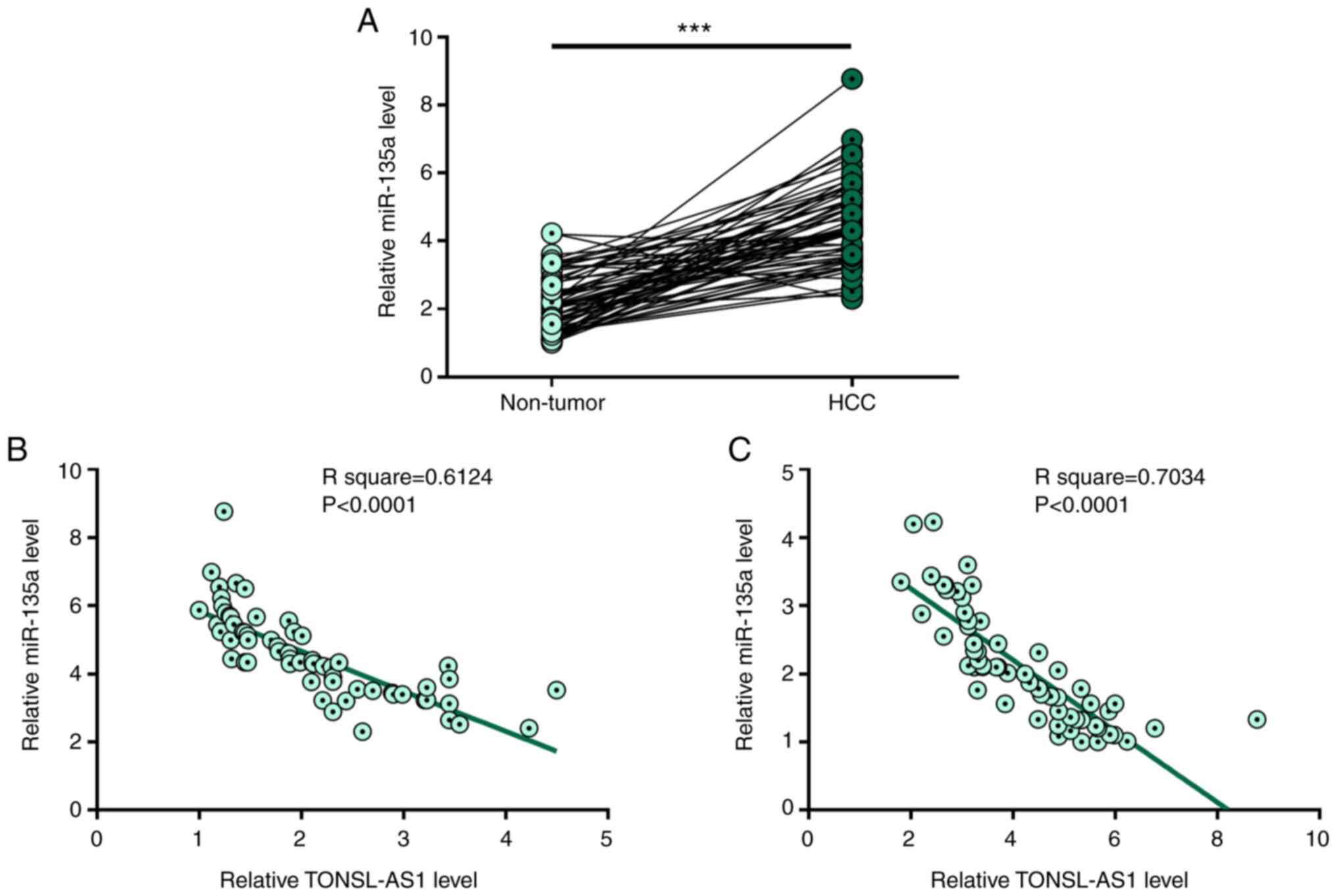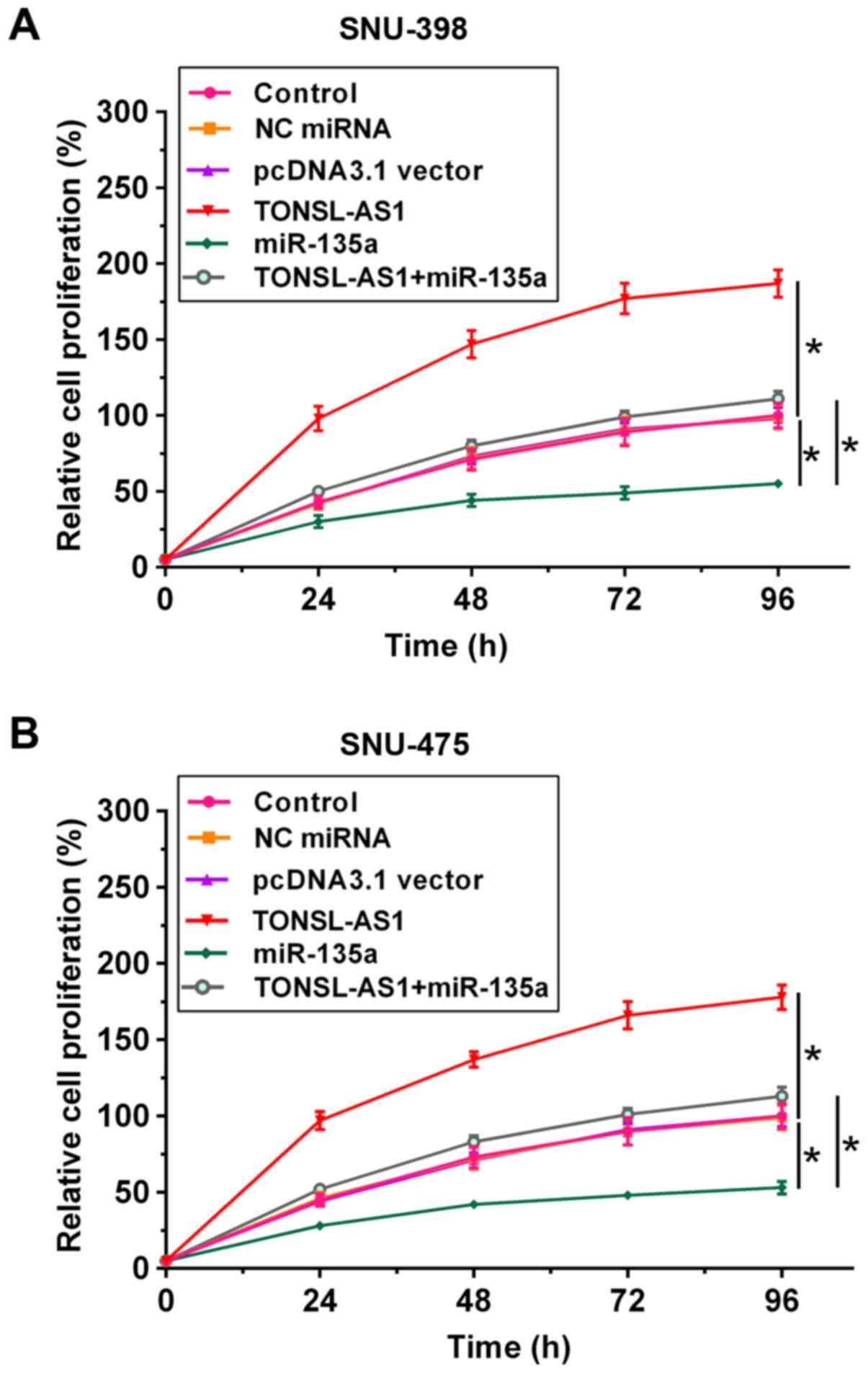MicroRNA‑135a expression is upregulated in hepatocellular carcinoma and targets long non‑coding RNA TONSL‑AS1 to suppress cell proliferation
- Authors:
- Published online on: September 24, 2021 https://doi.org/10.3892/ol.2021.13069
- Article Number: 808
-
Copyright: © Deng et al. This is an open access article distributed under the terms of Creative Commons Attribution License.
Abstract
Introduction
Liver cancer is one of the most common cancers and is a leading cause of cancer-associated mortality in several countries, including China and the United States (1,2). In 2018, liver cancer accounted for 8.2% of all cancer-associated mortalities and 4.7% of all cancer cases (3). Hepatocellular carcinoma (HCC) is the most common subtype of liver cancer, accounting for ~90% of all cases (4). HCC mainly affects patients with chronic liver diseases, such as hepatitis B vs. (HBV) or hepatitis C vs. (HCV)-induced cirrhosis (5). With the popularization of viral screening programs, the incidence of HCC is expected to decrease in the future (6). However, other factors, such as alcohol and tobacco consumption are also closely associated with HCC (7). Thus, other prevention and treatment approaches are still required.
In addition to viral infections, molecular factors also play critical roles in the initiation and development of HCC (8,9). Previous studies have demonstrated that certain molecules in HCC can be used to develop novel therapeutic targets, which aim to suppress cancer development by regulating gene expression (10,11). It is well-known that long non-coding RNAs (lncRNAs) exert their functions in cancer biology by regulating gene expression (12), suggesting that they may act as promising targets for targeted therapy (13). Thus, functional characterization of lncRNAs in cancers is required. lncRNA TONSL-AS1 acts as a tumor suppressor in gastric cancer; however, its role in HCC remains unknown (14). It was hypothesized that microRNA (miRNA/miR)-135a, a critical player in cancer biology (15), targets TONSL-AS1 in HCC. Thus, the present study aimed to investigate the role of TONSL-AS1 in HCC and determine the potential interactions between TONSL-AS1 and miR-135a in HCC.
Materials and methods
Patients and tissue samples
A total of 64 patients with HCC (38 men and 26 women; mean age, 52.1±6.9 years; age range, 40–64 years) at the First Affiliated Hospital of Shenzhen University were enrolled in the present study between January 2013 and January 2015. The inclusion criteria were as follows: i) Patients with pathologically confirmed HCC; ii) patients who underwent curative surgical resection and iii) patients >18 years. The exclusion criteria were as follows: i) Patients receiving preoperative chemotherapy or radiotherapy and ii) patients who have two or more primary tumors simultaneously or asynchronously. Prior to therapy, HCC tissues and paired adjacent normal tissues (>5 cm away from cancer tissues) were collected from all patients via biopsy. All the histological diagnoses for HCC and normal tissues were confirmed by two pathologists from the First Affiliated Hospital of Shenzhen University and immediately subjected to total RNA extraction following collection. Based on the medical records of all patients, HBV infection was observed in 26 cases, HCV infection was observed in 16 cases, both HBV and HCV infections were observed in 16 cases, and no infections were observed in 6 cases. The present study was approved by the Ethics Committee of the First Affiliated Hospital of Shenzhen University (Shenzhen, China; approval no. 2013006) and written informed consent was provided by all patients prior to the study start.
Treatment and follow-up
Based on the tumor-node-metastasis (TNM) staging system (16), of the 64 patients included, 28 cases were in stages I and II, while 36 cases were in stages III and IV. Treatment approaches were determined based on the TNM stage and health conditions of the patients. From June 30, 2015, all patients were followed-up for 5 years in a monthly manner through telephone to record their survival. The survival status of patients was recorded during follow-up until June 30, 2020. Patients who died of causes unrelated to HCC were excluded.
Survival analysis
Survival analysis was performed using the Kaplan-Meier method and log-rank test. Patients were divided into high and low TONSL-AS1 expression groups (n=32/group and median TONSL-AS1 expression in HCC tissues was set as the cut-off value).
IntaRNA2.0
The interaction between TONSL-AS1 and miR-135a was predicted using IntaRNA2.0 (http://rna.informatik.uni-freiburg.de/IntaRNA).
Cell lines and cell transfection
The HCC cell lines, SNU-398 and SNU-475, were purchased from the American Type Culture Collection. Cells were maintained in RPMI-1640 medium (Sigma, India; 90%) supplemented with 10% fetal bovine serum (MP Biomedicals), at 37°C with 5% CO2 and 95% humidity. Cells were collected once they reached ~85% confluence and used in subsequent experiments.
The TONSL-AS1 expressing vector was constructed with pcDNA3.1 vector as the backbone (Invitrogen; Thermo Fisher Scientific, Inc.). miR-135a mimic and negative control (NC) miRNA were synthesized by Invitrogen; Thermo Fisher Scientific, Inc. Vector (1 µg) or miRNA (50 nM) were transfected into SNU-398 and SNU-475 cells using Lipofectamine® 2000 reagent (Invitrogen; Thermo Fisher Scientific, Inc.), according to the manufacturer's instructions. Transfection with empty vector or NC miRNA served as the control groups, and control cells were untransfected cells. Cells were cultured for 48 h at 37°C with 5% CO2 and harvested for subsequent experimentation. Sequences of transfection vectors were as follows: miR-135a mimics forward, 5′-UAUGGCUUUUUAUUCCUAUGUGA-3′ and reverse, 5′-GUGCCGAGGAUUAGGGAUAUACU-3′; and NC mimics forward, 5′-UUCUCCGAACGUGUCACGUTT−3′ and reverse, 5′-ACGUGACACGUUCGGAGAATT−3′.
RNA preparation and reverse transcription-quantitative (RT-q)PCR
Total RNA was extracted from tissues and cells using RiboZol™ reagent (Amresco, LLC). RNA samples were digested to remove genomic DNA using DNase I (Invitrogen; Thermo Fisher Scientific, Inc.), at 37°C for 100 min. RNA integrity was assessed using 5% urine-PAGE gel.
Total RNA was reverse transcribed into cDNA using the PrimeScript RT reagent kit (Takara Bio, Inc.) at 37°C for 15 min. qPCR was subsequently performed using LightCycler® 480 SYBR Green I Master (Roche Diagnostics GmbH). The following thermocycling conditions were used for qPCR: Initial denaturation at 95°C for 30 sec, followed by 40 cycles at 95°C for 5 sec and at 60°C for 45 sec (17). The following primer sequences were used for qPCR: TONSL-AS1 forward, 5′-AGCCCTCTCTCCCTGCACCAC−3′ and reverse, 5′-AGCTGAGCACCTTCCTGAAACCC-3′; miR-135a forward, 5′-AGCATAATACAGCAGGCACAGAC-3′ and reverse, 5′-AAAGGTTGTTCTCCACTCTCTCAC−3′; and U6 forward, 5′-GCUUCGGCAGCACAUAUACUAAAAU-3′ and reverse, 5′-CGCUUCACGAAUUUGCGUGUCAU-3′. TONSL-AS1 expression was measured with 18S rRNA as the internal control.
miR-135a expression levels were measured as follows: i) Addition of poly (A); ii) RT of miRNA and iii) miRNA qPCR. U6 was used as the internal control. Relative expression levels were calculated using the 2−ΔΔcq method (18). All experiments were performed in triplicate.
Cell proliferation assay
The Cell Counting Kit-8 (CCK-8) assay (cat. no. ab228554; Abcam) was performed to assess the proliferative ability of SNU-398 and SNU-475 cells. Cells were seeded into 96-well plates at a density of 3,000 cells/well (in 0.1 ml medium) and cultured at 37°C, and optical density (OD) values were measured at a wavelength of 450 nm every 24 h for a total of 4 days. CCK-8 solution was added to each well for 2 h to reach 10% concentration, prior to analyzing cell proliferation.
Statistical analysis
All experiments were performed in triplicate and data are presented as the mean ± standard deviation. Differences between two groups were compared using an unpaired two-tailed Student's t-test, while one-way ANOVA and Tukey's post hoc test were used to compare differences between multiple groups. Unpaired Student's t-test was performed to assess the significance of cell proliferation assay. Pearson's correlation coefficient was used to determine the correlation between TONSL-AS1 and miR-135a expression levels. Survival analysis was performed using the Kaplan-Meier method and log-rank test. P<0.05 was considered to indicate a statistically significant difference.
Results
Downregulation of TONSL-AS1 expression predicts poor survival of patients with HCC
RT-qPCR analysis was performed to detect TONSL-AS1 expression in HCC tissues and paired adjacent normal tissues from 64 patients with HCC. The results demonstrated that TONSL-AS1 expression was significantly downregulated in HCC tissues compared with adjacent normal tissues (P<0.001; Fig. 1A). In addition, survival analysis demonstrated that patients with low TONSL-AS1 expression had significantly lower overall survival rates than those with high TONSL-AS1 expression (Fig. 1B). Notably, no significant differences in TONSL-AS1 expression were observed between patients in different clinical stages or patients with (mean value, 3.23±0.97) or without HBV/HCV (mean value, 3.04±0.72) infections (P>0.05) (data not shown). Taken together, these results suggest that TONSL-AS1 may be an independent prognostic factor for HCC.
miR-135a targets TONSL-AS1 in SNU-398 and SNU-475 cells
The interaction between miR-135a and TONSL-AS1 was predicted using IntaRNA2.0. The results indicated that miR-135a targets TONSL-AS1 (Fig. 2A). To further investigation their interaction, SNU-398 and SNU-475 cells were transfected with miR-135a mimic or TONSL-AS1 expression vector, and transfection efficiency was assessed via RT-qPCR analysis 48 h post-transfection (P<0.05; Fig. 2B). The results demonstrated that overexpression of miR-135a downregulated TONSL-AS1 expression (Fig. 2C), while overexpression of TONSL-AS1 had no effect on miR-135a expression (Fig. 2D).
TONSL-AS1 and miR-135a are inversely correlated with each other
RT-qPCR analysis was performed to detect miR-135a expression in HCC tissues and paired adjacent normal tissues from 64 patients with HCC. The results demonstrated that miR-135a expression was significantly upregulated in HCC tissues compared with adjacent normal tissues (P<0.001; Fig. 3A). In addition, Pearson's correlation coefficient analysis demonstrated that TONSL-AS1 and miR-135a expression levels were inversely correlated with each other in both HCC tissues (Fig. 3B) and adjacent normal tissues (Fig. 3C). Collectively, these results suggest that TONSL-AS1 and miR-135a interact with each other.
miR-135a targets TONSL-AS1 to promote HCC cell proliferation
The CCK-8 assay was performed to assess the effects of miR-135a and TONSL-AS1 on the proliferative ability of HCC cells. The results demonstrated that overexpression of miR-135a increased the proliferation of SNU-398 and SNU-475 cells that compared with the control group. Conversely, overexpression of TONSL-AS1 decreased cell proliferation. In addition, overexpression of miR-135a attenuated the effect of overexpression of TONSL-AS1 on cell proliferation (P<0.05; Fig. 4A and B).
Discussion
The present study aimed to investigate the interaction between miR-135a and TONSL-AS1 in HCC. The results demonstrated that miR-135a and TONSL-AS1 expression levels were altered in HCC. In addition, miR-135a may target TONSL-AS1 to promote the proliferation of HCC cells.
A recent study demonstrated the involvement of lncRNA TONSL-AS1 in HCC (14). It has been demonstrated that TONSL-AS1 expression is downregulated in HCC, and overexpression of TONSL-AS1 inhibits cancer cell invasion, migration and proliferation (15). To the best of our knowledge, the present study was the first to investigate the role of TONSL-AS1 in HCC. The results of the present study demonstrated that overexpression of TONSL-AS1 decreased the proliferation of HCC cells, suggesting that TONSL-AS1 may act as a tumor suppressor in HCC.
It is estimated that <15% of patients with HCC survive >5 years following the initial diagnosis, even with effective treatment (19). Due to the lack of effective therapeutic approaches, the low survival rate is unlikely to be significantly improved in the future. The results of the present study demonstrated that high TONSL-AS1 expression was closely associated with favorable survival outcomes in patients with HCC. Thus, measuring TONSL-AS1 expression prior to therapy may assist the prognosis of patients with HCC, thereby guiding the determination of treatment approaches. However, further clinical studies are required to confirm the results presented here.
miR-135a plays different roles in different types of cancer (15,20). For example, miR-135a targets HOXA10 to promote breast cancer cell invasion and migration (15). In addition, miR-135a targets PHLPP2 and FOXO1 to promote the proliferation of bladder cancer cells (20). The results of the present study demonstrated that miR-135a expression was upregulated in HCC, which in turn promoted cancer cell proliferation. Thus, miR-135a is likely to act as an oncogene in HCC. These results are consistent with previous findings that miR-135a promotes the progression of HCC (21,22). However, these previous studies have only reported the role of miR-135a in enhancing the metastasis of HCC, whereas the present study suggests that miR-135a may also accelerate the growth of HCC.
Previous studies have demonstrated that miR-135a targets protein-coding genes to participate in cancer biology (23–25). The results of the present study demonstrated that miR-135a targeted TONSL-AS1 to participate in HCC. Taken together, these results provide insight on the functionality of miR-135a in cancer biology.
The present study is not without limitations. The effects of TONSL-AS1/miR-135a on several signaling pathways remain to be elucidated. In addition, the targets of miR-135a associated with HCC need to be investigated. Thus, a comprehensive analysis is required in the future. In conclusion, the results of the present study suggest that TONSL-AS1 expression is downregulated and miR-135a expression is upregulated in HCC. In addition, miR-135a can target TONSL-AS1 to promote HCC cell proliferation.
Acknowledgements
Not applicable.
Funding
The present study was supported by the Science and Technology Planning Project of Guangdong Province (grant no. 2014A020212701), the Medical Scientific Research Foundation of Guangdong Province (grant no. B2014326), the Medical Scientific Research Foundation of Guangdong Province (grant no. A2017338), the Chinese Foundation for Hepatitis Prevention and Control (grant no. TQGB20180220) and Shenzhen Municipal Science and Technology Foundation (grant no. JCYJ20190806162818268).
Availability of data and materials
The datasets used and/or analyzed during the present study are available from the corresponding author upon reasonable request.
Authors' contributions
XD and JC acquired funding, performed the experiments, analyzed the data and drafted the initial manuscript. NZ, JC and YZ performed the experiments, and performed the literature review and clinical research. CL and YN managed the project, and performed the literature review and clinical research. XD and YN confirmed the authenticity of all the raw data. All authors have read and approved the final manuscript.
Ethics approval and consent to participate
The present study was approved by the Ethics Committee of the First Affiliated Hospital of Shenzhen University (Shenzhen, China; approval no. 2013006) and written informed consent was provided by all patients prior to the study start.
Patient consent for publication
Not applicable.
Competing interests
The authors declare that they have no competing interests.
References
|
Zuo TT, Zheng RS, Zhang SW, Zeng HM and Chen WQ: Incidence and mortality of liver cancer in China in 2011. Chin J Cancer. 34:508–513. 2015. View Article : Google Scholar : PubMed/NCBI | |
|
Altekruse SF, Henley SJ, Cucinelli JE and McGlynn KA: Changing hepatocellular carcinoma incidence and liver cancer mortality rates in the United States. Am J Gastroenterol. 109:542–553. 2014. View Article : Google Scholar : PubMed/NCBI | |
|
Bray F, Ferlay J, Soerjomataram I, Siegel RL, Torre LA and Jemal A: Global cancer statistics 2018: GLOBOCAN estimates of incidence and mortality worldwide for 36 cancers in 185 countries. CA Cancer J Clin. 68:394–424. 2018. View Article : Google Scholar : PubMed/NCBI | |
|
Kulik L and El-Serag HB: Epidemiology and management of hepatocellular carcinoma. Gastroenterology. 156:477–491.e1. 2019. View Article : Google Scholar : PubMed/NCBI | |
|
Hiotis SP, Rahbari NN, Villanueva GA, Klegar E, Luan W, Wang Q and Yee HT: Hepatitis B vs hepatitis C infection on viral hepatitis-associated hepatocellular carcinoma. BMC Gastroenterol. 12:642012. View Article : Google Scholar : PubMed/NCBI | |
|
Lu T, Seto WK, Zhu RX, Lai CL and Yuen MF: Prevention of hepatocellular carcinoma in chronic viral hepatitis B and C infection. World J Gastroenterol. 19:8887–8894. 2013. View Article : Google Scholar : PubMed/NCBI | |
|
Saran U, Humar B, Kolly P and Dufour JF: Hepatocellular carcinoma and lifestyles. J Hepatol. 64:203–214. 2016. View Article : Google Scholar : PubMed/NCBI | |
|
Tarocchi M, Polvani S, Marroncini G and Galli A: Molecular mechanism of hepatitis B virus-induced hepatocarcinogenesis. World J Gastroenterol. 20:11630–11640. 2014. View Article : Google Scholar : PubMed/NCBI | |
|
Marra M, Sordelli IM, Lombardi A, Lamberti M, Tarantino L, Giudice A, Stiuso P, Abbruzzese A, Sperlongano R, Accardo M, et al: Molecular targets and oxidative stress biomarkers in hepatocellular carcinoma: An overview. J Transl Med. 9:1712011. View Article : Google Scholar : PubMed/NCBI | |
|
Sawey ET, Chanrion M, Cai C, Wu G, Zhang J, Zender L, Zhao A, Busuttil RW, Yee H, Stein L, et al: Identification of a therapeutic strategy targeting amplified FGF19 in liver cancer by oncogenomic screening. Cancer Cell. 19:347–358. 2011. View Article : Google Scholar : PubMed/NCBI | |
|
Pan W, Li W, Zhao J, Huang Z, Zhao J, Chen S, Wang C, Xue Y, Huang F, Fang Q, et al: lncRNA-PDPK2P promotes hepatocellular carcinoma progression through the PDK1/AKT/Caspase 3 pathway. Mol Oncol. 13:2246–2258. 2019. View Article : Google Scholar : PubMed/NCBI | |
|
Esteller M: Non-coding RNAs in human disease. Nat Rev Genet. 12:861–874. 2011. View Article : Google Scholar : PubMed/NCBI | |
|
Li CH and Chen Y: Targeting long non-coding RNAs in cancers: Progress and prospects. Int J Biochem Cell Biol. 45:1895–1910. 2013. View Article : Google Scholar : PubMed/NCBI | |
|
Wang P, Yang X, Zhao L, Liu D, Liu J and Ding Y: A novel long non-coding RNA TONSL-AS1 regulates progression of gastric cancer via activating TONSL. Exp Cell Res. 382:1114532019. View Article : Google Scholar : PubMed/NCBI | |
|
Chen Y, Zhang J, Wang H, Zhao J, Xu C, Du Y, Luo X, Zheng F, Liu R, Zhang H and Ma D: miRNA-135a promotes breast cancer cell migration and invasion by targeting HOXA10. BMC Cancer. 12:1112012. View Article : Google Scholar : PubMed/NCBI | |
|
Park S, Choi S, Cho YA, Sinn DH, Kim JM, Park CK and Ha SY: Evaluation of the American joint committee on cancer (AJCC) 8th edition staging system for hepatocellular carcinoma in 1,008 patients with curative resection. Cancer Res Treat. 52:1145–1152. 2020.PubMed/NCBI | |
|
Lang N, Wang C, Zhao J, Shi F, Wu T and Cao H: Long non-coding RNA BCYRN1 promotes glycolysis and tumor progression by regulating the miR-149/PKM2 axis in non-small-cell lung cancer. Mol Med Rep. 21:1509–1516. 2020.PubMed/NCBI | |
|
Livak KJ and Schmittgen TD: Analysis of relative gene expression data using real-time quantitative PCR and the 2(-Delta Delta C(T)) method. Methods. 25:402–408. 2001. View Article : Google Scholar : PubMed/NCBI | |
|
Bertuccio P, Turati F, Carioli G, Rodriguez T, La Vecchia C, Malvezzi M and Negri E: Global trends and predictions in hepatocellular carcinoma mortality. J Hepatol. 67:302–309. 2017. View Article : Google Scholar : PubMed/NCBI | |
|
Mao XP, Zhang LS, Huang B, Zhou SY, Liao J, Chen LW, Qiu SP and Chen JX: Mir-135a enhances cellular proliferation through post-transcriptionally regulating PHLPP2 and FOXO1 in human bladder cancer. J Transl Med. 13:862015. View Article : Google Scholar : PubMed/NCBI | |
|
Liu S, Guo W, Shi J, Li N, Yu X, Xue J, Fu X, Chu K, Lu C, Zhao J, et al: MicroRNA-135a contributes to the development of portal vein tumor thrombus by promoting metastasis in hepatocellular carcinoma. J Hepatol. 56:389–396. 2012. View Article : Google Scholar : PubMed/NCBI | |
|
Zeng YB, Liang XH, Zhang GX, Jiang N, Zhang T, Huang JY, Zhang L and Zeng XC: miRNA-135a promotes hepatocellular carcinoma cell migration and invasion by targeting forkhead box O1. Cancer Cell Int. 16:632016. View Article : Google Scholar : PubMed/NCBI | |
|
Xie Y, Li F, Li Z and Shi Z: miR-135a suppresses migration of gastric cancer cells by targeting TRAF5-mediated NF-κB activation. Onco Targets Ther. 12:975–984. 2019. View Article : Google Scholar : PubMed/NCBI | |
|
Yang C, Zheng X, Ye K, Sun Y, Lu Y, Fan Q and Ge H: miR-135a inhibits the invasion and migration of esophageal cancer stem cells through the hedgehog signaling pathway by targeting Smo. Mol Ther Nucleic Acids. 19:841–852. 2020. View Article : Google Scholar : PubMed/NCBI | |
|
Wang J, Yang J, Zhang H, Liao Y, Xu D and Ma S: Effects of miR-135a-5p and miR-141 on proliferation, invasion and apoptosis of colorectal cancer SW620 cells. Oncol Lett. 20:914–920. 2020. View Article : Google Scholar : PubMed/NCBI |













